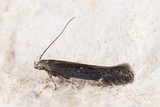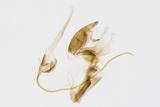Aproaerema anthyllidella (Hübner, 1813) Species
Last modified: Jan. 3, 2024, 3:36 p.m.
A fairly common species throughout Belgium.
Details
- Classification
- Family: Gelechiidae > Subfamily: Anacampsinae > Tribus: Anacampsini > Genus: Aproaerema > Species: Aproaerema anthyllidella
- Vernacular names
- Wondklaverpalpmot (NL), Vetch Sober, Vetch Moth (EN), Wundklee-Palpenmotte (DE)
- First mention in Belgium
- De Fré Ch. 1858. Catalogue des Microlépidoptères de la Belgique. — Annales de la Société entomologique belge 2: 45–162. On page 135.
- Status
-
Native
Distribution
Imago
Wingspan 10–12 mm. A rather variable species both in size and forewing colouration, ranging from slaty fuscous to blackish fuscous. It may have a yellowish spot in the fold, and there is some range in the intensity of the yellow ochreous costal and tornal markings from whitish to dull ochreous or even obsolescence. It has also scattered pale scales in the distal third on the forewing.
Adults can be confused with Aproaerema vinella, Oxypteryx atrella and Oxypteryx immaculatella.
Caterpillar
Larva short, broad, somewhat depressed, the segments strongly constricted, shiny with fat red-brown warts with individual short lighter bristles. Head small, heart-shaped, shiny, black-brown. Neck shield with broad black-brown shiny spot. The body is whitish in the incisions between the 2nd and 3rd and between the 3rd and 4th segments.
Mine
See also bladmineerders.be
The mine forms a greenish-white, multi-lobed spot on the upper side of the leaves, usually extending from the area of the leaf stalk. As the caterpillar gets older, it contracts the leaf upwards in the area of the stem in a pod-like manner; in smaller leaves up to the tip.
Cocoon/pupa
Pupa bulbous, narrowed towards the back, smooth, shiny, black.
Bionomics
The caterpillar mines when it is young with frass concentrated in one corner of the mine. Later it lives in spun together leaves on the host plant. Some of the caterpillars leave the mines before winter, while others overwinter in the evergreen leaves. When the larva leaves the larval habitation it creates a narrow, elongated, thin, light gray web in which it becomes a pupa in April.
The adults fly both during the day and at night and later comes to light.
Flight periods
The adults fly from mid-April towards late October in two generations a year.
Observed on
- Host plant (species):
- Onobrychis viciifolia, Trifolium pratense, Medicago sativa, Medicago lupulina and Hippocrepis comosa
- Host plant (genera):
- Anthyllis, Lathyrus, Ononis and Lotus
The larva lives on the leaves of Anthyllis vulneraria, Onobrychis viciifolia, Onobrychis arenaria, Trifolium pratense, Medicago lupulina, Medicago sativa, Hippocrepis comosa, Ononis sp., Lathyrus sp., Lotus creticus, Lotus tenellus and Bituminaria bituminosa.
Habitat
It ocurs on rough grasslands, meadow land and dry pastures.




